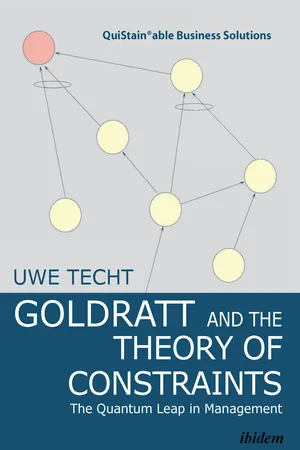
This is a test
- English
- ePUB (mobile friendly)
- Available on iOS & Android
eBook - ePub
Book details
Book preview
Table of contents
Citations
About This Book
This book uses engaging language and real-life examples to provide an overview of the methods and tools of the theory of constraints: drum-buffer-rope, buffer management, throughput accounting, pull distribution, irresistible offer, corporate strategy, and viable vision. It explains how to recognize and use constraints, complete projects quickly and reliably, and gain a competitive lead and turn it into profit.
Frequently asked questions
At the moment all of our mobile-responsive ePub books are available to download via the app. Most of our PDFs are also available to download and we're working on making the final remaining ones downloadable now. Learn more here.
Both plans give you full access to the library and all of Perlego’s features. The only differences are the price and subscription period: With the annual plan you’ll save around 30% compared to 12 months on the monthly plan.
We are an online textbook subscription service, where you can get access to an entire online library for less than the price of a single book per month. With over 1 million books across 1000+ topics, we’ve got you covered! Learn more here.
Look out for the read-aloud symbol on your next book to see if you can listen to it. The read-aloud tool reads text aloud for you, highlighting the text as it is being read. You can pause it, speed it up and slow it down. Learn more here.
Yes, you can access Goldratt and the Theory of Constraints by Uwe Techt in PDF and/or ePUB format, as well as other popular books in Business & Management. We have over one million books available in our catalogue for you to explore.
Information
What about finances?
Oh yes, “constraint thinking” has far-reaching consequences—especially in terms of financial indicators and decisions. Your management will have to rethink their strategies … Why?
“Tell me how you are measuring me and I will tell you how I will behave.”
However, commonly used business indicators lead to mistakes in management. It is therefore important to act.
Problem: Cost accounting
We have mentioned this previously: Managers tend to fixate on cost and, therefore, do not pay enough attention to throughput. But just as dramatically, a cost-oriented view leads to far-reaching mistakes. Here are some examples:
Cost considerations
Let's assume a facility breaks down for a certain period of time, e.g., one hour. We would traditionally have derived the ensuing losses from the cost of the facility.
But if this facility is the whole system's constraint, then the losses are considered the lost throughput of the entire system for the duration of one hour.
If this facility isn't the constraint of the entire system, and the system's constraint isn't affected by the facility's breakdown, then there will be no losses from the breakdown (excluding repairs, etc.).
What is the impact of this new constraint-focused view on the decision-making speed regarding repair or replacement of the facility?
Division of tasks
The decision as to which resource should complete which task is traditionally determined by cost analysis: The resource that can complete a task most cost-efficiently has to do it.
Once we have identified a constraint and it is possible to relieve the constraint of tasks, then this is what we must do. Because, one hour saved at the constraint signifies one additional hour of throughput for the entire system. All other resources have excess capacity, so it is not a problem for them to relieve the constraint—even if this is “less cost-efficient” going by pure cost analysis.
Investment decisions
Decisions on whether an investment is worth it are often made on the basis of anticipated cost savings.
Example: You want to decide whether to acquire new equipment. These are the details:
· Cost of the new machine: $100,000
· The new machine works twice as fast as the current one: The current one produces 6 units/hour, the new one produces 12 units/hour.
· Yearly quantity to be produced: 30,000 units
· Labor: $8/hour
· Overhead factor: 4
How do you calculate whether the purchase of the machine is “worth” it?
The traditional process is this: First you calculate the saved time per unit: 10 min (old machine) − 5 min (new machine) = 5 min/unit.
You project the result for a whole year: 5 min/unit * 30,000 units/year = 2,500 hours/year.
This time is converted into cost savings.
· Cost saved per hour: Labor + overhead = $8/hour + (4 * 8 $/hour) = $40/hour.
· Cost saved per year: $40/hour * 2,500 hours = $100,000.
Finally you will calculate the payback period:
Cost of the machine ($100,000)/cost savings per year ($100,000/year) = 1 year.
But, will you actually have made the cost of the new machine at the end of the year?
We can only answer this question if we know one further piece of information: Is the old (and new) machine used at the constraint?
It is not used at the constraint? Then there is no chance we will have made the $100,000 after 1 year. You will not make more sales thanks to the new machine. Y...
Table of contents
- Preface
- Why this book?
- Acknowledgements
- What are the goals of the ToC?
- What are my business targets?
- Earning money—what exactly does it mean?
- What keeps us from earning money?
- We are not producing enough!
- What about finances?
- What lies behind the constraint?
- Our stock levels are too high … and often too low!
- Our projects are taking too long!
- How can projects become even faster?
- Our clients aren't queuing for our products
- How can I convince everyone else?
- So is ToC a corporate strategy?
- Looking ahead